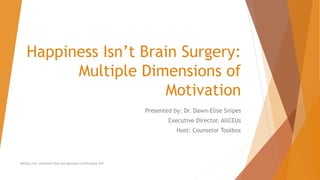Happiness isn’t brain surgery multiple dimensions of motivation
The video for this presentation is available on our Youtube channel: https://youtube.com/allceuseducation A continuing education course for this presentation can be found at https://www.allceus.com/member/cart/index/index?c= Courses are available for this topic at https://www.allceus.com/member/cart/index/search?q=motivation AllCEUs provides counseling education and CEs for LPCs, LMHCs, LMFTs and LCSWs as well as addiction counselor precertification training and continuing education. Live, Interactive Webinars ($5): https://www.allceus.com/live-interactive-webinars/ Unlimited Counseling CEs for $59 https://www.allceus.com/ Specialty Certificate tracks starting at $89 https://www.allceus.com/certificate-tracks/ Live Webinars $5/hour https://www.allceus.com/live-interactive-webinars/ Patreon: https://www.patreon.com/CounselorToolbox Help us keep the videos free for everyone to learn by becoming a patron. Pinterest: drsnipes Podcast: https://www.allceus.com/counselortoolbox/ Nurses, addiction and mental health counselors, social workers and marriage and family therapists can earn CEs for this and other presentations at AllCEUs.com AllCEUs has been approved by NBCC as an Approved Continuing Education Provider, ACEP No. 6261. Programs that do not qualify for NBCC Credit are clearly identified. AllCEUs is solely responsible for all aspects of the programs. AllCEUs is also approved as an education provider for NAADAC, the States of Florida and Texas Boards of Social Work and Mental Health/Professional Counseling, the California Consortium for Addiction Professionals and Professions. Our courses are accepted in most states through those approvals.

Recommended
Recommended
More Related Content
What's hot
What's hot (18)
Viewers also liked
Viewers also liked (20)
Similar to Happiness isn’t brain surgery multiple dimensions of motivation
Similar to Happiness isn’t brain surgery multiple dimensions of motivation (20)
More from Dr. DawnElise Snipes ★AllCEUs★ Unlimited Counselor Training
More from Dr. DawnElise Snipes ★AllCEUs★ Unlimited Counselor Training (20)
Recently uploaded
Recently uploaded (20)
Happiness isn’t brain surgery multiple dimensions of motivation
- 1. Happiness Isn’t Brain Surgery: Multiple Dimensions of Motivation Presented by: Dr. Dawn-Elise Snipes Executive Director, AllCEUs Host: Counselor Toolbox AllCEUs.com Unlimited CEUs and Specialty Certifications $59
- 2. Objectives Define motivation Review the concepts of motivation Identify the types of motivation and ways to enhance them
- 3. What is motivation Motivation is doing something to get a reward Assumptions about the nature of motivation: Motivation is a key to change. Motivation is multidimensional. Motivation is dynamic and fluctuating When the going gets tough, motivation gets going Motivation can be modified. Additional rewards can be added to make the new behavior more rewarding, even in the face of adversity
- 4. Enhancing Motivation The PIES Approach Proximity: Provide intervention in the natural environment Immediacy: Intervene as soon as the problem or loss of motivation is noticed. Expectancy: Expect the intervention to be successful and emphasize self-efficacy. Simplicity: Listen, show empathy, and demonstrate understanding works best.
- 5. Tips The more types of motivation involved, the stronger the motivational force Signs of decreasing motivation Failure to attempt change “Resistance” Excuses and “yes, buts” Lack of enthusiasm Have client’s rate their motivation on each target behavior (not goal) each day. Goal: Lose 15 pounds Target behavior: Go to the gym Target behavior: Drink 8 glasses of water…
- 6. Apply It Goals & Target Behavior Goal: Improve happiness (address depression) Target Behavior: Take medication Target Behavior: Walk 30 minutes Target Behavior: When I feel sad, write in my journal Goal: Improve Stress Management (reduce anxiety) Target Behavior 1: Get adequate sleep Target Behavior 2: Delegate unnecessary stressors Target Behavior 3: Reduce caffeine
- 7. Types of Motivation Emotional: Makes the person happy Mental: Is the logical choice Physical: Improves physical health, energy or reduces pain Social: Improves relationship with self or others, elicits positive feedback from self and others Spiritual: Is in alignment with values Financial: Increases financial independence Environmental: Makes the environment more comfortable
- 8. Emotional Motivation Things that make the person happy Decisional Balance: Identify all the reasons Increase these The new behavior makes the person happy (Positive reinforcement) The old behavior adds distress (Negative reinforcement) Decrease these The old behavior makes the person happy The new behavior adds distress Especially useful with people who have more of a “Feeling” temperament
- 9. Mental Motivation Things that the person sees as logical Available information to support desired behavior Decisional Balance: Identify all the reasons Increase these The new behavior is logical and helpful to achieving goals The old behavior is unhelpful to achieving goals Decrease these The old behavior is logical and helpful to achieving goals The new behavior is unhelpful to achieving goals Especially useful with people who have a “Thinking” temperament.
- 10. Social Motivation Things that increase the person’s self-esteem/self- acceptance Things that increase social approval/acceptance Decisional Balance: Identify all the reasons Increase these The new behavior increases self-acceptance/approval & other acceptance/approval The old behavior is in opposition to their self-concept The old behavior leads to rejection/isolation Decrease these The old behavior is socially rewarding The new behavior does not provide self or other rewards (i.e. changing people, places, things)
- 11. Spiritual Motivation Highlight ways that the new behavior is in alignment with values Decisional Balance: Increase these Ways the new behavior is in alignment with values Awareness of ways old behaviors are not in alignment with values Decrease these The ways the old behavior aligns with values The ways the new behavior does not align with values
- 12. Financial Motivation Highlight ways that the new behavior is financially beneficial Decisional Balance How did old behaviors reduce Savings Additional money Redirectable funds How do new behaviors increase Savings Additional money Redirectable funds
- 13. Environmental Motivation Identifying ways the new behavior will allow the person to improve their environment People: Kindred spirits Places: Vacation, better neighborhood, nice restaurant Things: upgraded car, redecorating, Decisional balance: In what ways will the new behavior (Highlight) Improve the environment Make the environment more stressful In what was does the old behavior (decrease) Create a comfortable environment (What will you miss?) Create an uncomfortable environment
- 14. Summary Motivation is essential to behavior change Motivation involves “choosing” the behavior that provides the greatest rewards for the effort. Increasing motivation means enhancing rewards and reducing punishments/drawbacks.
